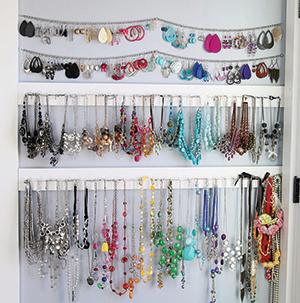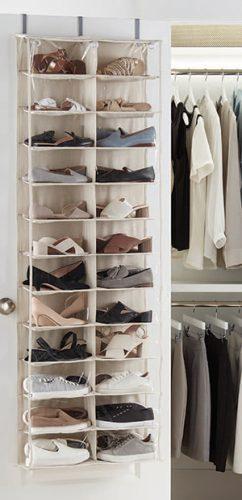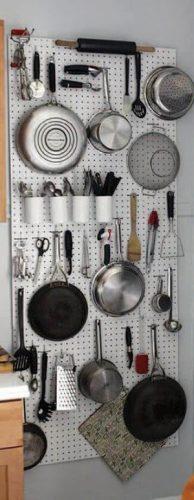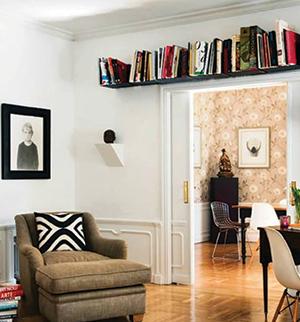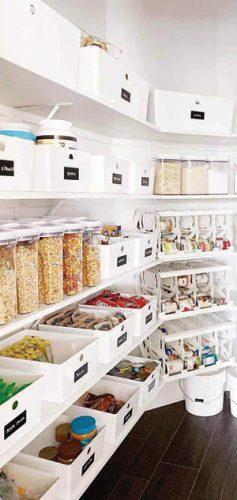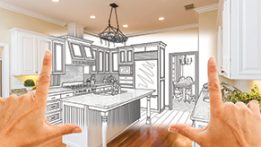No matter how much square footage your home has, it never seems to be enough. Oftentimes, storage space is difficult to come by. Whether it’s hanging and mounted displays, shelves, built-in and nesting furniture, boxing and unboxing techniques, or making use of unused or nontraditional spaces, become inspired by our tips and tricks for creative storage solutions in your home.
One of the best storage techniques you can implement is to think vertically. Incorporating hanging, mounted, and shelved displays can save space all over your home. Wall hooks and pegs, for instance, can hold a variety of items. Jewelry spends a lot of its life tangled up in a drawer. By hanging your everyday beads, bracelets, necklaces, rings, and earrings on miniature wall hooks, you free up drawer space and keep those items from tangling and potentially breaking. The same can be said for storing hats and handbags. Instead of losing closet space to bulky hat boxes and heaps of handbags, hang these items on wall hooks. Installing accessory displays like these maximizes your closet space and decorates your bedroom in a chic fashion. To organize your closet further, consider implementing collapsible clothing hangers. These hanging racks comprise of multiple hangers that collapse vertically, allowing you to store approximately six times more clothing than you would using normal hangers.
In addition to hangers, you can drape a door hanging display over the inside of your closet door. These pocket organizers are so versatile that you can store just about anything that fits inside them. In fact, shoes are a common culprit of shrinking closet space, whether they are stored in a grounded shoe rack or kept on a shelf. Thus, shoe storage is the most typical use of these organizers; however, other stored items can include toys, ties, tees, and other articles of clothing. You can even drape a hanging door display over the inside of your pantry door to store pre-packaged snacks, such as potato chips and juice boxes. Elsewhere in the kitchen, you can install ceiling suspended racks above your cooking area to store pots, skillets, spatulas, spoons, and even wine glasses. This frees up cabinet and drawer space and allows you to readily find and use your cooking supplies. You can also store your cooking utensils on a wall-mounted peg board. These boards allow you to hang a variety of items from their numerous pegs. Smaller peg boards can be mounted above desk spaces to hold office and crafting supplies. Larger floor-to-ceiling peg boards can be mounted in your basement or garage to hold gardening tools, such as shovels, shears, and rakes. If you keep your bicycle in your basement or garage, you can further maximize the space by mounting your bicycle on your wall using pegs or hooks. You can even mount it in the foyer or living room to create your own whimsical decor and allow easy access to your bicycle. In the bathroom, shower caddies are great space savers. By hanging a shower caddy from your shower faucet, you can hold the shampoos, soaps, and sponges that would normally clutter the rim of your shower or tub.
Like wall hooks and pegs, shelves are a great way to store and display items. Although bookshelves and bookcases may be what first come to mind, know that shelves come in many shapes and sizes. Ladder shelves, for instance, are pieces of furniture made to look like large ladders leading to nowhere. Tilted at a 45° angle, they can display an array of items on their leveled rungs. They are versatile in function and match the aesthetic of any bedroom, living room, or bathroom. Floating shelves are simple and minimal. Like ladder shelves, floating shelves are a suitable fit in any room and can hold an array of items. As their name suggests, these individual planks can be mounted on your wall at any height and distance from each other, unlike bookcases or bookshelves. Consequently, there is nothing stopping you from mounting these above your doorway or window. By mounting each plank side by side along the length of your wall, you can create one long shelf above your door or window to display those items that you may not need to access as often, such as antique books or picture frames.
Although built-in furniture is capable of storing a similar amount of items as their freestanding foils, they save more square footage. Built-in bookshelves and fold down beds are a good example. Not only are there vertical storage techniques, but consider building down as well. For storing excess clothing, you can also install built-in storage beneath the bed. These are known as platform storage beds, in which drawers slide out from beneath the bed frame to store excess or out-of-season clothing. Next is nesting furniture. These pieces consist of multiple attachable and detachable moving parts that can expand to accommodate necessary situations. These include dining tables with liftable flaps on either side, tables whose proper benches and seating slide in and out underneath, or sofas whose base can be pulled out to convert the couch into a bed. There are also storage benches, ottomans, and coffee tables whose hoods open to reveal storage room.
Another common storage solution is the use of boxes, bags, baskets, and cubbies. Trunks and toy chests that are placed at the end of the bed have the ability to store a large amount of linens, clothing, or toys while blending into the surrounding furniture. You can also store out-of-season clothing in vacuum bags to compact these items for easy storage and seal them from any dust that might accumulate over time. While baskets are highly functional, they are wonderfully decorative. Coming in all shapes and sizes, their uses have a large range. Miniature cubbies can be placed inside your desk drawers, sock drawers, or kitchen drawers to keep your items separate, organized, and easy to find. Should you run out of room in your desk drawers, consider adding a hutch above it. These extra shelves can house even more cubbies. When it comes to tangled or excess charging cables near the monitors and electronic devices around the house, consider storing them in charging bins or stations to keep them organized.
While bins and cubbies are classic storage techniques, feel free to think outside the box. Oftentimes, packaging can lead you to simply toss your items in a pantry or under the sink. Yet, what if you were to unbox these items instead? Pantries are filled with miscellaneous and beaten up cereals, sugars, spices, jams, flour, and pastas. By unboxing these items and placing them in labeled jars or clear containers, you not only store them for easy access but create a decorative display for your countertop. This can also be done with the cotton balls and cotton swabs in your bathroom. Creating this decorative display saves space for those truly unattractive toilet plunger and bleach bottles under the sink.
Finally, make use of unused and nontraditional spaces. Rooms like attics, garages, and basements have untapped potential. These can be additional guest rooms or play rooms waiting to be converted. In two-story houses, install a built-in hutch with extra shelf, cabinet, and drawer storage beneath your staircase. Take advantage of every nook and cranny you see.
Storage space is hard to come by in our homes. Thus, maximizing space takes a little creativity. By taking advantage of your walls and ceilings, opting in for built-in furniture, boxing and unboxing your stored items, as well as making use of unused spaces, you’ll be sure to find new room. ![]()
Andrea Lopez
Home & Yard Magazine



